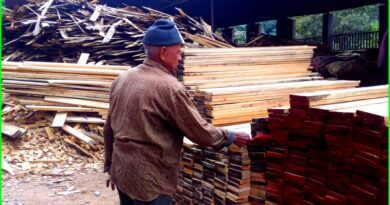Introduction to Forest Mensuration
orestry, in the broadest sense, is a management activity involving the plants and animals growing on it. This management has to take into account man's desire to use forest and their produce. Forest Mensuration is that branch of forestry which deals with the determination of dimensions (e.g., diameter, height, volume, etc. ,), form, age and increment of single trees, stands or whole woods, either standing or after felling. It includes measurements of felled and standing trees, sawn wood and round logs and various other products referred to as minor forest products such as bamboos, charcoal, bark, fruits, etc. Forest mensuration, therefore, concerns with linear, area, volume and weight measurements. While volume is the most important measurement from the point of view of forest management, weight, which is also referred to as biomass is being increasingly used now in place of volume.
Objectives
Forest mensuration serves the following objects
(a) Basis for sale —
Forest mensuration forms the basis of every transaction involving sale of forests or their products. In olden days when supplies were ample and the value of timber or any other forest produce was low, measurements may not have been necessary but with the increasing gap between demand and supply and the rising prices of timber or other products, it has assumed great importance. Before any sale, the forest department prepares estimates of the quantity of timber or other produce contained in various sale lots and the value which each lot is likely to fetch. Similarly, the contractors or other purchasing agencies estimate the material they would receive from the lots and the maximum price they could pay to the forest department to earn a reasonable profit after meeting working costs. This has resulted in development of methods of measurements and calculations which give reasonably accurate estimates of timber and other forest produce in the lots and their prices.
(b) Basis of management —
With proper management, forests can meet the demand of timber and other forest produce in perpetuity. For this purpose, a knowledge of the quantity of timber standing in forest and the increment it is putting on every year or in a period of years is necessary. This led to the development of methods of preparing forest inventories using satellite imageries, aerial photographs and various optical and electronic techniques so that forests could be harvested without depleting the capital.
(c) Measurement for research —
In order to find out which treatment and method of management would maximise production, it is necessary to layout experiments to compare the results of different treatments. This required the laying out of sample plots and their periodic measurements.
(d) Measurement for planning —
The forester is concerned not only with the demands on forests at present but also with those of the future. With the steeply increasing population and rising standards of living every year, the gap between the demands and supplies of timber and other forest products is widening fast and therefore, the forest manager has to plan to reduce this gap. For this purpose, fast-growing species have to be introduced. This requires not only reasonably accurate estimates of future yields but also the cost of production so that such projects may be financially sound. Thus, forest mensuration supplies basic statistical data to plan for the future and serves as a yardstick to check the viability of projects.
Scope
Forest mensuration has a very wide scope. It concerns not only the foresters, contractors, sawyers and transport labour working in the forest but also the sawmillers and wood-using public in the cities, towns and villages. It comes into play every time the wood is sold, converted or used. While it deals with the measurement of cubical contents of trees and crops at present, it also helps in the forecast of yields at any time in their future life. It applies not only to standing trees and crops but also to felled timber and its subsequent conversion till it is used in some work.
With the widening of horizon of forestry, the scope of forest mensuration has also widened. The present day forest mensurationist has to concern himself with the measurement problems of wild life management, watershed management, insect and disease incidence, recreation, tourism and, in fact, many of the mensurational aspects of multiple-use forestry. Traditional measurement problems, however, remain a major responsibility. In short, forest mensuration should be regarded as the branch of forestry which provides foundations of measurement principles applicable to any forest measurement problem. The application of statistical theory and the use of electronic computer for data processing have brought about revolutionary changes in forest measurement problems. Forest mensuration should make full use of these tools but its principles must be based oil sound biological knowledge.

